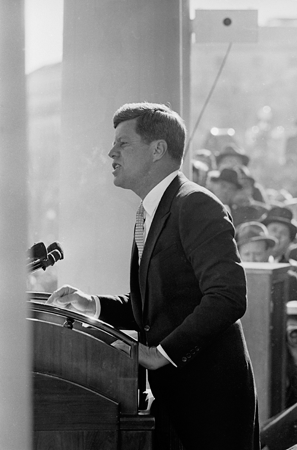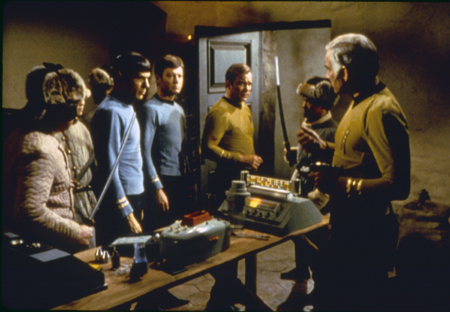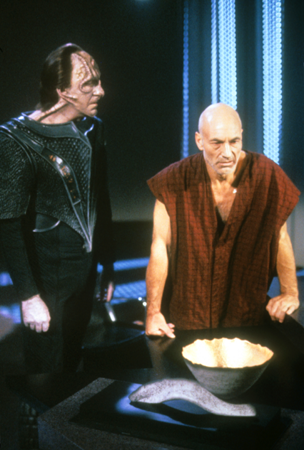
A POLITICAL ENTERPRISE
FROM VIETNAM IN THE 1960S TO MORE RECENT DEBATES ABOUT TORTURE AND TERRORISM, EACH STAR TREK SERIES CHARTED A COLLISION COURSE WITH SOCIAL ISSUES
BY SUSANNA SCHROBSDORFF

In “A Private Little War” (1968), the Enterprise crew find that the planet Neural, home to a primitive society, is being supplied with weapons by the Klingons.
CONSIDER THIS AMAZING FACT: A SHOW THAT BEGAN 50 YEARS ago as a sci-fi fantasy with embarrassingly cheap sets, awkward fight scenes and some very bad wigs turned out to be an enduring platform for serious political and social commentary. From racism to the ethics of global interventionism, Star Trek took on topics that seemed untouchable and beamed them right into prime time, all lightly disguised in alien makeup.
Sure, there were certain episodes in the original series of the 1960s that didn’t slip under the radar, like the one with that famous Kirk-Uhura interracial kiss. But as Star Trek has been reincarnated decade after decade, it has continued to both reflect its times and challenge them, slyly poking at the most tender and divisive issues in American culture.
The early politics of the show were driven by creator Gene Roddenberry’s vision of a future in which humans have evolved to the point where all races can live together and there is no war. For a country with vivid memories of World War II and worries about the nuclear threat, Star Trek was the ultimate escape—a small-screen view of the furthest reaches of President John F. Kennedy’s New Frontier. “It showed you what the world might look like in 400 years if you were in some kind of fantasy,” says William Shatner, who played Capt. James T. Kirk.
The bridge of the U.S.S. Enterprise reflected that fantasy. Roddenberry was a vet and had been a pilot in the Pacific theater, where the United States had engaged in horrific battles with Japanese forces. But on the Enterprise, that animosity was long healed; to prove it, Roddenberry put a Japanese American, George Takei, on the bridge as Lt. Sulu. Takei and his family had been in an American internment camp during the war, making his presence even more poignant.
In the real world of the ’60s, the conflict between the U.S. and the Soviet Union was heating up, but Roddenberry’s crew dared to add a Russian officer, Pavel Chekov (Walter Koenig). And as civil rights battles spilled into America’s streets and played out on everyone’s television screens, Roddenberry cast an African-American woman, Nichelle Nichols, as communications officer Lt. Uhura. At the time, just having a woman on the bridge of a (quasi-)military vessel was a bit transgressive; a black woman was revolutionary. Then there was Leonard Nimoy’s Spock, an officer of mixed race (half Vulcan, half human)—which was also a subversive concept at the time.
RODDENBERRY’S MULTICULTURAL CREW MAY have been a symbol of a harmonious future, but the battles they faced in space were rooted in the conflicts of the time. “Star Trek directly reflected the politics of the Kennedy era and the Cold War,” says Paul Cantor, a professor of English at the University of Virginia and a Star Trek scholar. “Fundamentally the United Federation of Planets was the United States,” he says. “The Klingons were Russians and militaristic, while the Federation stood for democracy and liberalism.”
The core of Roddenberry’s moral universe was the Prime Directive, a standing order that forbids Starfleet personnel from interfering with other cultures—even if the goal is to help. From the start, it was a rule meant to be broken, or at least debated. That tension was central to the show, says Shatner. “When does the intuitive conscience of man take precedence over the written law? When do you interfere, and when do you not interfere? It’s a question that’s been asked a lot in politics,” he says. “And in our case, in Star Trek, it added to the drama of an individual flying in the face of bureaucracy.”
In fact, Kirk seemed to be constantly violating the Prime Directive. “It became a bit of a joke,” says Cantor. “Every episode is about interference in some planet. And what it came down to is that we don’t interfere in another planet, provided it looks exactly like Kennedy’s 1960s America.”
This idea that America was both the protector of freedom and the standard by which other countries should be judged permeated the original Star Trek. The tone had been set by Kennedy’s landmark 1961 inaugural speech, which was practically a mandate for intervention. The U.S. would, Kennedy said, “pay any price, bear any burden, meet any hardship, support any friend, oppose any foe to assure the survival and the success of liberty.”
That’s the real directive Kirk seemed to be following. Timothy Sandefur, an adjunct scholar at the Cato Institute and a Star Trek fan, points out that the show once went so far as to have Kirk rapturously recite the preamble to the Constitution. In that episode, “The Omega Glory,” two races are at war: the “Yangs” (yankees) and the “Kohms” (communists), who represent the Americans and the Chinese. But the Yangs have become savages. They’ve forgotten the values imbued in the tattered American flag and the crumbling copy of the Constitution that they worship. Kirk steps in to set things right, and when First Officer Spock objects, he explains, “We merely showed them the meaning of what they were fighting for. Liberty and freedom have to be more than just words.”
Another episode evoked the liberation of the death camps in World War II. In “A Taste of Armageddon,” the Enterprise crew discover a planet that has been in a civil war for decades—but fighting only by computer. There are no bombs, and civilization is not destroyed. Instead, when one side suffers damages in a computerized “attack,” it must execute a commensurate number of citizens. Kirk is unable to let this systemized slaughter continue, and he intervenes. “We don’t make war with computers and herd the casualties into suicide stations,” he says before blowing up the death machines.
Shatner suggests that “Armageddon” foreshadows modern warfare, with its drones and remote-controlled bombs. “It’s a war by computer where the nations had lost sight of how horrible war is,” he says. “It has ramifications, particularly now. What was science fiction then has become science fact now. But what remains is the human confusion, the human chaos of what to do and how to do it.”
Toward the end of the original series, the threshold for intervention seemed less clear. By 1968, casualties were mounting in Vietnam and young people were protesting the draft. “A Private Little War” was an overt allegory of America’s involvement in the conflict. In it, a peaceful but primitive people get caught between two superpowers. Kirk discovers that some of them have been armed with rifles by the Klingons. Kirk, after some debate, decides to give weapons to the other side. His rationale is a Cold War primer: “A balance of power. The trickiest, most difficult, dirtiest game of them all, but the only one that preserves both sides.”
Perhaps the most powerful political statement made by any Star Trek episode in any era was that of “Let That Be Your Last Battlefield,” which took on racism. The Enterprise beams up two alien survivors of a long war. One of them is black on the right side of his face and white on the other side. The second alien has the reverse pattern. And they despise each other as a result. Once aboard, the two try to kill each other, causing chaos. They are returned to their planet, where presumably they live out their lives in hate.
The episode aired in 1969, the year after Martin Luther King Jr. was assassinated and not long before the series was canceled. It is one of Shatner’s favorites. “That was such a brilliant concept,” he says. “I’d never seen that before and never seen it done again as brilliantly, imaginatively showing us the ignorance and the stupidity of racism.” It was written by Gene Coon, another military vet, who produced 33 episodes and whom Shatner describes as “the real generator of the success of Star Trek.”
IF 1960S TREK WAS ALL ABOUT BEING A HERO, then Star Trek: The Next Generation, which premiered in 1987, portrayed a more complicated moral universe. “You start off in the first Star Trek, and the Earth is effectively the center of the universe, of everything,” explains Paul Cantor. But when Next Generation debuted, the Iron Curtain was about to fall, the Cold War was ending, and a polarized view of the world was beginning to dissolve. “This is when you first get a sense [in the series] that there are forces out there that may be superior, whole civilizations that may be more advanced,” says Cantor.
Unlike Kirk, the new captain of the Enterprise, Jean-Luc Picard, is not a classic American hero. He’s not even American; he’s French. And he’s played by British actor Patrick Stewart. Picard has a different interpretation of the Prime Directive. When the Enterprise discovers a race that is keeping people on a nearby planet addicted to a drug to enslave them, the ship’s medical officer, Beverly Crusher (Gates McFadden), begs Picard to help. Picard declines: “It is not for me to make any of these decisions,” he says. “The Prime Directive is not just a set of rules; it is a philosophy . . . and a very correct one.” Picard reflects post-Vietnam America’s skittishness when he adds, “History has proved again and again that whenever mankind interferes with a less developed civilization, no matter how well-intentioned that interference may be, the results are invariably disastrous.”
Timothy Sandefur sees Picard’s reluctance to get involved as a shift from Roddenberry’s original vision: “In The Next Generation, the Prime Directive becomes a dogma based on moral and cultural relativism, symptomatic of the Clinton era. That continued until September 11. Since then, the idea that there is such a thing as genuine evil has seen a resurgence among liberal intellectuals.”
Still, TNG broke some political ground. Star Trek had long been criticized for not having a recurring gay character. But Jeri Taylor, a writer and executive producer on the series, addressed homosexuality in at least one episode. In “The Outcast,” a race of androgynous beings has banned all identifications of male or female gender. When one of the beings comes out as female, she’s threatened with a kind of sexual re-education. Taylor says it would have been difficult to broach homophobia at the time other than through science fiction. “It allowed the freedom to talk about bias and intolerance in a way that would be much harder for people to hear if it were presented in a contemporary context,” she says.
The Next Generation was eerily prescient about some ethical questions that continue to this day. The most searing example is probably the 1992 episode “Chain of Command.” Written years before the invasion of Iraq, it echoes some of the excruciating debates about torture Americans would have after 9/11. The story has Picard captured by the Cardassians, a hostile race developing biological weapons of mass destruction. Picard protests his treatment, saying he’s protected as a prisoner of war under a 24th-century analogue of the Geneva Conventions, but the Cardassians use a loophole in the definition of “prisoner of war” and leave the captain naked and strung up by the wrists all night.
The next day, the chief torturer shines four lights in Picard’s eyes repeatedly, and, using a remote control that applies pain, he insists that Picard say there are five lights. Picard resists, taunting his captor: “Torture has never been a reliable means of extracting information. It is ultimately self-defeating as a means of control. One wonders that it’s still practiced.” Just before Picard collapses entirely, his crewmates negotiate his release. Later, Picard tells the ship’s counselor that he did not break, but he admits he would have if he hadn’t been rescued. He says he would have said anything to get relief. And he adds, “But more than that, I believed that I could see five lights.”
ANOTHER POLITICAL ISSUE THAT SURFACED IN 1990s Star Trek and still runs hot today is income disparity. Deep Space Nine, a spinoff about a Federation outpost that guards the opening of a wormhole, debuted in 1993 with the series’s first African-American lead, Avery Brooks, as Cdr. Benjamin Sisko. In “Past Tense,” Sisko and two crew members, Julian Bashir (Alexander Siddig) and Jadzia Dax (Terry Farrell), accidentally end up in San Francisco circa 2024. At that time, the country’s jobless “gimmes” and the mentally ill “dims” were segregated into “Sanctuary Districts,” similar to debtors’ prisons. Outside, the wealthy live undisturbed by the desperation in the camps. But a violent revolution causes the public to turn against the slums and finally deal with poverty and homelessness.
When this episode aired in 1995, the U.S. was conflicted over a welfare-reform bill (enacted in 1996) that pushed “personal responsibility” and cut aid. The debate flared up again in the 2016 presidential primaries when Social Democrat Bernie Sanders ignited a populist movement against entrenched economic inequality.
Star Trek: Voyager debuted in 1995 as The Next Generation was ending. Its crew is immediately stranded in the far-off Delta Quadrant and faces a 75-year journey to return home. Not only are our new heroes not the center of the universe, they can’t even see Earth. And, perhaps not coincidentally, the leader of this lost ship is Star Trek’s first female captain, Kathryn Janeway (Kate Mulgrew). Even in the ’90s, putting a woman at the lead of this iconic franchise was risky. Taylor, who helped create Voyager with producer and writer Rick Berman, says making her plausible wasn’t easy.
“You have to assume that your captain can take care of things and is going to make the right decisions,” Taylor says. “On the other hand, we didn’t want to make her a man with breasts. I felt very strongly that there is a female sensibility and that that could be incorporated into this character without damaging her position. She could be intuitive, compassionate and feeling as well as having all the steely strength that she needed.” Sometimes it came down to Mulgrew’s hairstyle. “If it’s too severe, then she loses her humanity. If it’s too glamorous, she won’t be taken seriously as a captain,” says Taylor. Get it wrong, and fans would show their displeasure. It hasn’t escaped Taylor’s notice that 20 years after Janeway took the bridge, female leaders are seen still trying to walk that line. (Just ask Hillary Clinton.)
Janeway is trying to get her crew home, not save the world. But Voyager often shows her as nostalgic for the days when this new frontier was like the Wild West. “Space must have seemed a whole lot bigger back then,” she says of the original Enterprise. “It’s not surprising they had to bend the rules a little. They were a little slower to invoke the Prime Directive and a little quicker to pull their phasers,” she says. “But I have to admit, I would have loved to ride shotgun at least once with a group of officers like that.”
Enterprise, a prequel set about 100 years before Kirk and Spock’s time, was the first Star Trek series produced after the attacks of 9/11. A new American ethos of defending the homeland at all costs is threaded throughout the show. In the third season, Earth is attacked by a terrorist group and 7 million people are killed. The Enterprise is retrofitted as a military vessel so it can protect the planet.
That’s not the only thing that was retro about Enterprise. While Voyager put women on the bridge, Enterprise put them back in bikinis. In “Bound,” Capt. Jonathan Archer (Scott Bakula) receives a gift of beautiful green Orion slaves who mesmerize the male members of the crew with seductive dances. It is later discovered that the women emit hormones that make the men weak. Eventually, the crew concludes that it’s really the men of Orion who are the slaves, not the women. “It’s really the worst situation of victim blaming and stereotyping,” says Timothy Sandefur. And given how sexual politics have changed even in the past 10 years, if this had first aired today, the producers would have been flooded with social-media outrage.
There hasn’t been a Star Trek series since Enterprise ended in 2005. But CBS is cooking up a new one for 2017. And it won’t be surprising if the creators try to revive some of the spirit of the original series. Those old-school heroics and all that moral certainty might be just the perfect balm for our new age of angst.

John F. Kennedy’s 1961 inaugural promise that the U.S. would “bear any burden, meet any hardship, support any friend, oppose any foe to assure the survival and the success of liberty” was regularly echoed in the plots and themes of the 1960s series.

“Let That Be Your Last Battlefield” (1969), which examined a violent racial conflict, aired less than one year after the death of Martin Luther King Jr.

In “The Omega Glory” (1968), Kirk cites the U.S. Constitution: “Look at these three words . . . tall words proudly saying, ‘We the People.’ ”

In The Next Generation’s “Chain of Command, Part II” (1992), Picard (right) protests his torture by his captors, citing an agreement governing treatment of prisoners of war.

When Voyager debuted in 1995, the namesake ship was stranded far from the Federation and helmed by female captain Kathryn Janeway.

The cast of Enterprise poses for a promotional shot. The most recent incarnation of the Star Trek franchise premiered just weeks after the 9/11 attacks.
Susanna Schrobsdorff is assistant managing editor at TIME .